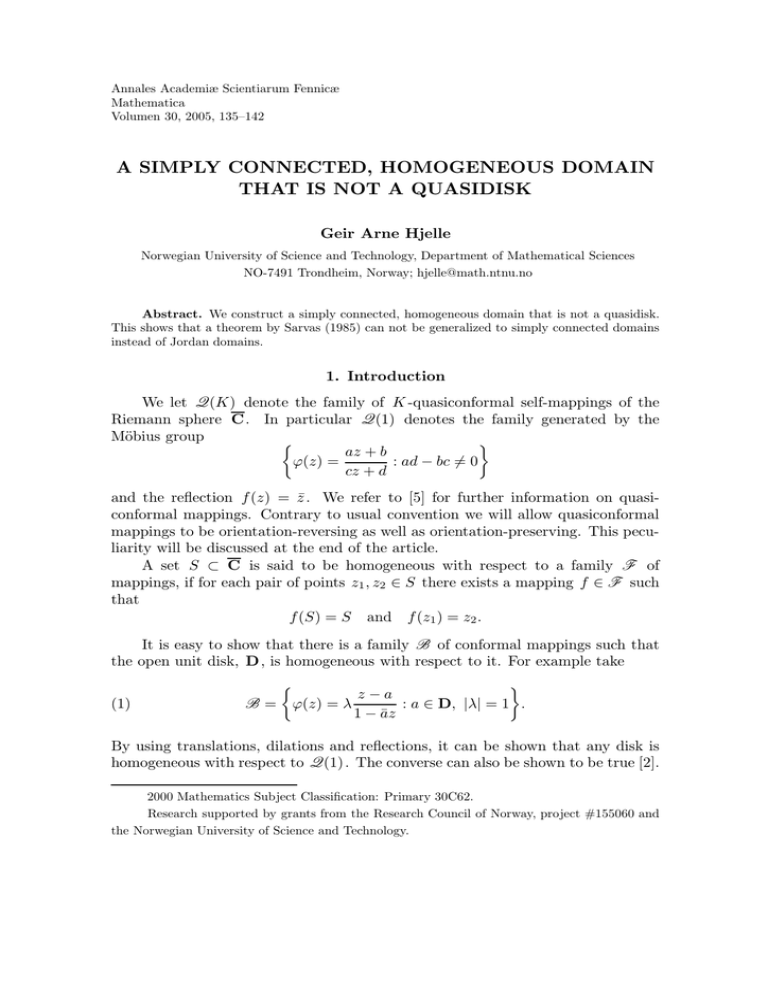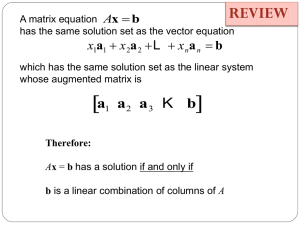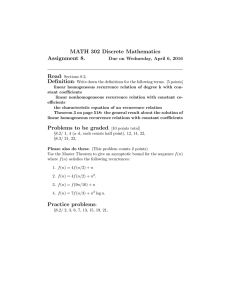A SIMPLY CONNECTED, HOMOGENEOUS DOMAIN THAT IS NOT A QUASIDISK
advertisement

Annales Academiæ Scientiarum Fennicæ
Mathematica
Volumen 30, 2005, 135–142
A SIMPLY CONNECTED, HOMOGENEOUS DOMAIN
THAT IS NOT A QUASIDISK
Geir Arne Hjelle
Norwegian University of Science and Technology, Department of Mathematical Sciences
NO-7491 Trondheim, Norway; hjelle@math.ntnu.no
Abstract. We construct a simply connected, homogeneous domain that is not a quasidisk.
This shows that a theorem by Sarvas (1985) can not be generalized to simply connected domains
instead of Jordan domains.
1. Introduction
We let Q(K) denote the family of K -quasiconformal self-mappings of the
Riemann sphere C. In particular Q(1) denotes the family generated by the
Möbius group
az + b
: ad − bc 6= 0
ϕ(z) =
cz + d
and the reflection f (z) = z̄ . We refer to [5] for further information on quasiconformal mappings. Contrary to usual convention we will allow quasiconformal
mappings to be orientation-reversing as well as orientation-preserving. This peculiarity will be discussed at the end of the article.
A set S ⊂ C is said to be homogeneous with respect to a family F of
mappings, if for each pair of points z1 , z2 ∈ S there exists a mapping f ∈ F such
that
f (S) = S and f (z1 ) = z2 .
It is easy to show that there is a family B of conformal mappings such that
the open unit disk, D , is homogeneous with respect to it. For example take
(1)
B=
z−a
ϕ(z) = λ
: a ∈ D, |λ| = 1 .
1 − āz
By using translations, dilations and reflections, it can be shown that any disk is
homogeneous with respect to Q(1) . The converse can also be shown to be true [2].
2000 Mathematics Subject Classification: Primary 30C62.
Research supported by grants from the Research Council of Norway, project #155060 and
the Norwegian University of Science and Technology.
136
Geir Arne Hjelle
Theorem 1. A domain D is a disk if and only if it is homogeneous with
respect to the family Q(1) .
The mappings ϕ in (1) distorts the boundary of D . If we require the boundary to be left untouched, a conformal map will no longer do the job. Instead we
rely on a theorem of Teichmüller. He pointed out that given a compact set E
in the unit disk, any point in E can be mapped to any other point in E by a
K -quasiconformal mapping f . Moreover, f can be chosen to fix the boundary of
D [8].
We will now look at the connection between homogeneity and quasidisks. In
1977 Timo Erkama proved the following result for the boundary [1].
Theorem 2. A simply connected domain D is a quasidisk if and only if ∂D
is homogeneous with respect to the family Q(K) for some fixed K .
A few years later Jukka Sarvas proved a similar theorem concerning homogeneity of the domain [7].
Theorem 3. A Jordan domain D is a quasidisk if and only if it is homogeneous with respect to the family Q(K) for some fixed K .
2. A simply connected, homogeneous domain
In Theorem 2 a simply connected domain is sufficient, while a Jordan domain
is crucial in Sarvas’ proof of Theorem 3. We will now show that the hypothesis of
the latter theorem can not be weakened to also include simply connected domains.
This result has been known for some time and a preprint by Näkki and Palka on
the matter exists [6]. Their construction is based on the same technique used in
Example 4.6 of [3] and some results from the field of Kleinian groups. We will
present an example which does not rely on this theory.
Theorem 4. There exists a simply connected domain D , homogeneous with
respect to Q(K) for some fixed K , that is not a quasidisk.
We start by constructing the domain. Let r1 and r2 be reflections in the
circles |z + 2| = 1 and |z − 2| = 1 , respectively, and let t denote the translation
t(z) = z + i . Define G0 = {r1 , r2 , t, t−1 } and let G be the group generated by the
elements of G0 . Finally denote by E the closed set
p
E = z = x + iy : |x| ≤ 2 − 1 − y 2 , |y| ≤ 21 .
See Figure 1. The domain D will then be given by the union
D=
S
g∈G
g(E).
A simply connected, homogeneous domain that is not a quasidisk
t ◦ r1 (E)
r1 ◦ t ◦ r1 (E)
137
t(E)
E
r1 ◦ t(E)
r1 ◦ t−1 (E)
r1 (E)
t−1 (E)
r1 ◦ t−1 ◦ r1 (E)
t−1 ◦ r1 (E)
Figure 1. The set E , the two circles we reflect in and some of the other components of D .
The domain D will be an infinite “strip” and is indicated in Figure 2.
Let us introduce some more notation. A set P = g(E) with g ∈ G is called
a component of D . If g = gn ◦ · · · ◦ g1 and n is minimal, P is called an n th
generation component and is denoted P (n) . We also define
S (i)
.
(2)
Dn = int
P
i≤n
Observe that we can introduce a metric dc on the set of components in the fol(i)
(j)
lowing way: Let P1 = ϕ(E) and P2 = ψ(E) with ϕ, ψ ∈ G , and let n be
the generation of P = ψ ◦ ϕ−1 (E) . Define dc (P1 , P2 ) = n . Also note that for
P (n) = g(E) = gn ◦ · · · ◦ g1 (E) the union of the n components
n
S
i=1
gn ◦ · · · ◦ gi (E)
is path connected. Thus, dc (P1 , P2 ) = n and the minimality of n implies that the
shortest path from P1 to P2 crosses n − 1 other components.
Before we go on to show that D is a simply connected, homogeneous domain,
we prove two key lemmas.
Lemma 1. Dn as defined in (2) is a simply connected domain for all n =
0, 1, 2, . . . .
Proof. We use induction. Clearly D0 = int(E) is simply connected. Assume
Dn−1 is simply connected. We will show that D n−1 ∪P (n) is simply connected for
all P (n) . Then also Dn will be simply connected as two different n th generation
components do not have any point in common that is not already in D n−1 .
138
Geir Arne Hjelle
E
E
Figure 2. The domain D and its components. To the left is a blown-up image showing more detail.
Obviously D n−1 ∪ P (n) is connected. We must make sure that the addition of
P
does not split the boundary into two or more parts, or equivalently we must
see that the set D n−1 ∩ P (n) is connected. Seeking a contradiction we assume
that D n−1 ∩ P (n) is disconnected. P (n) is surrounded by four components of
generation n − 1 or n + 1 . We can illustrate the situation as follows:
(n)
(n−1)
P1
P (n+1)
P (n)
P (n+1)
(n−1)
P2
The black lines mark D n−1 ∩ P (n) . Let g = gn ◦ · · · ◦ g1 be such that
P (n) = g(E) with gi ∈ G0 . Then
(n−1)
(1)
P1
P (n+1)
P (n)
P (n+1)
(n−1)
g −1
P1
P (1)
P (0) = E
P (1)
(1)
P2
P2
because there are no components of generation −1 . Thus there are ϕj ∈ G0 such
(1)
that Pj = ϕj (E) for j = 1, 2 . Moreover, ϕ1 and ϕ2 can be chosen such that
either ϕ1 = t and ϕ2 = t−1 , or ϕ1 = r1 and ϕ2 = r2 . But then
(3)
(n−1)
P j = Pj
= g ϕj (E) = gn ◦ · · · ◦ g1 ◦ ϕj (E).
The components Pj are of generation n − 1 , hence some of the terms in (3) must
cancel for both j = 1, 2 . To make the remaining discussion less abstract, assume
g1 = t and ϕ1 = t , ϕ2 = t−1 . The other cases may be treated equally.
A simply connected, homogeneous domain that is not a quasidisk
139
Clearly P2 = gn ◦ · · · ◦ g2 ◦ t ◦ t−1 (E) = gn ◦ · · · ◦ g2 (E) is of generation n − 1 .
Let h−1 = gn ◦ · · · ◦ g2 and consider h(P1 ) = h ◦ gn ◦ · · · ◦ g2 ◦ t ◦ t(E) = t ◦ t(E) .
We want to find the shortest path from h(E) to t ◦ t(E) and hence calculate
dc h(E), t ◦ t(E) . As g = gn ◦ · · · ◦ g1 is minimal, we know that
the shortest path
from h(E) to t(E) goes through E and that dc h(E), t(E) = n . This implies
that h(E) does not lie above E , or in other words that h(E) lies below the line
y = 21 . It is then easy to realize that dc h(E), t ◦ t(E) = n + 1 by considering
Figure 2. The reason is that a shortest path would use the components tn (E) ,
n ∈ Z as much as possible.
This contradicts the assumption that P1 is of generation n − 1 and therefore
also that D n−1 ∪ P (n) is disconnected.
Lemma 2. D is contained in the infinite strip {z : | Re z| < 2} .
Proof. Let L and R denote the two halfplanes L = {z ∈ C : Re z ≤ −2}
and R = {z ∈ C : Re z ≥ 2} . We will show that g(L ∪ R) does not meet E for
any g ∈ G . Let Λ be the set of all disks g(R) , g ∈ G , that touch L (excluding
R itself) and define L0 = r1 (R) ∈ Λ . We claim that L0 is the biggest disk in Λ .
Any disk Lλ ∈ Λ can be written
Lλ = tnm+1 ◦ r1 ◦ tnm ◦ · · · ◦ r1 ◦ tn1 ,
ni ∈ Z.
Represent a disk Lλ by the pair (a, %) where a = Im zλ and zλ is the center
of Lλ . The value % denotes the radius of Lλ . To calculate % observe thatthe
m
reflection r1 takes the disk (a, %) to (1/a, %/a2) . Define the sequence (ai , %i ) i=0
by
r ◦tn1
r ◦tnm
L0 ∼ (a0 , %0 ) 1−→ (a1 , %1 ) −→ · · · 1−→ (am , %m ).
As the translation tnm+1 does not affect the radius of Lλ we have % = %m .
Obviously ai ∈ Q so write ai = bi /ci with bi , ci ∈ Z and let a0 = b0 = 0 and
c0 = 1 . Then
1
1
ci−1
ai =
=
=
bi−1
ai−1 + ni
bi−1 + ci−1 ni
+ ni
ci−1
or bi = ci−1 and ci = bi−1 + ci−1 ni . We now claim that %i = %0 /c2i and prove
this by induction. For i = 0 the claim is obvious. Assume the relation holds for
i = k − 1 . Then for i = k ,
%k−1
%0 b2k
%0 c2k−1
%0
2
%k =
= %k−1 · ak = 2 · 2 = 2 · 2 = 2 .
2
(ak−1 + nk )
ck−1 ck
ck−1
ck
ck
As cm ∈ Z we get that % = %m is either infinite, or smaller than or equal to %0
which is the radius of L0 . The case when % is infinite is when L0 is mapped on
the halfplane R . Since R is not in Λ , L0 is the biggest disk in Λ .
140
Geir Arne Hjelle
Using that L0 is both the biggest disk in Λ and the disk in ΛSclosest to the
point z = 2 , shows that the bulb L̃0 containing L0 is the bulb in g∈G g(L ∪ R)
coming closest to E . Now define the sequence of points (zi ) by
z0 = −2,
z1 = r1 (2),
z2 = r1 ◦ r2 (−2),
z3 = r1 ◦ r2 ◦ r1 (2),
... .
Then limi→∞ zi will be the point in L̃0 furthest away from z = −2 ∈ L . Let di
be the distance di = |2 − zi | . Then
d0 = 4,
di = 4 −
1
di−1
,
i ≥ 1.
√
3 . So
Thus limi→∞ di is the attracting fixed point
of
f
=
4
−
1/f
,
which
is
2
+
√ √
the bulb L̃0 reaches a distance of 4 − 2 + 3 = 2 − 3 < 1 away from z = −2
and hence does not meet E .
Having proved these lemmas, we are ready to prove Theorem 4. We first show
that D is open. Let F be the union of images of E under the identity and the
sixteen mappings
rj ,
t,
t−1 ,
rj ◦ t,
rj ◦ t−1 ,
t ◦ rj ,
t−1 ◦ rj ,
rj ◦ t ◦ r j ,
rj ◦ t−1 ◦ rj
for j = 1, 2 . See Figure 1. Take F0 to be the interior of FS. Then F0 is an
open set which properly contains E . Hence we can write D = g∈G g(F0 ) and it
follows that D is open, because it is the union of open sets.
To see that D is simply connected observe that D = ∪Dn and Dn ⊆ Dn+1 ,
where Dn was defined in (2). As each Dn is a simply connected domain, the
complements Dn∗ = C \ Dn will be closed, compact and connected sets. Since
∗
(Dn∗ )n is a decreasing sequence, Dn∗ ⊆ Dn−1
, with D ∗ = ∩Dn∗ , D ∗ is also closed,
compact and connected. Hence D is simply connected.
Next we prove the homogeneity of D . By Riemann’s mapping theorem F0 ⊆
D can be mapped onto the unit disk by a conformal mapping f . E is a compact
subset of F0 , so f (E) is a compact subset of f (F0 ) = D . So by Teichmüller’s
theorem [8], for any pair of points z1 , z2 ∈ f (E) there exists a K -quasiconformal
self-mapping h of C which is the identity outside f (F0 ) and maps z1 to z2 . From
the construction of D , for any point z ∈ D there exists a mapping g ∈ G and a
point w ∈ E such that z = g(w) . Altogether, it follows that D is homogeneous
with respect to the family
F = G ◦ f −1 ◦ {h} ◦ f ◦ G ⊆ Q(K).
To complete the proof, we show that D is not locally connected at ∞ ∈ ∂D .
It will follow that D is not a Jordan domain and hence not a quasidisk. We
construct a neighborhood of ∞ in the following way: For n ∈ N , let
Cn = {z : | Re z| ≤ 2n, | Im z| ≤ n}.
A simply connected, homogeneous domain that is not a quasidisk
141
Then Cn∗ is a neighborhood of ∞ . Fix n ≥ 1 . For any neighborhood U ⊆ Cn∗
there is a number m ∈ N such that the points z1 = (n + m)i and z2 = −(n + m)i
are in U ∩ D . However, the two points can not be connected in Cn∗ ∩ D because
D is contained in the strip {z : | Re z| < 2} . Thus D is not locally connected at
∞.
3. Remarks
To end things off we provide a few comments. First of all, for the construction
to work as it is, we must admit Q(K) to contain both orientation-preserving and
orientation-reversing mappings. Usually a K -quasiconformal mapping is orientation-preserving by definition. In particular this is the case in the theorems of
Erkama and Sarvas.
The example is however easily modified to use a family of orientation-preserving mappings only. The orientation is reversed each time we apply a reflection, rj .
So for g ∈ G to be orientation-preserving, it must consist of an even number of
reflections.
e = E ∪ r1 (E) . In the example we found for each z ∈ D a mapping
Let E
g ∈ G and a point w ∈ E with z = g(w) . If g consists of an even number of
reflections, define g̃ = g and w
e = w . If not, let g̃ = g ◦ r1 and w
e = r1 (w) . Then
g̃ ∈ G is an orientation-preserving mapping such that z = g̃(w)
e for some point
e. E
e will be a compact subset of some Fe0 ⊂ D . Thus the same construction
w
e∈E
e , g̃ and w
of a homogeneous family as before can be carried out, but now with E
e
instead of E , g and w .
As a second comment, we remark that the same construction can be done in
more generality. Define r1 and r2 to be the reflections in the circles |z +b| = a and
|z − b| = a , and t to be the translation t(z) = z + ia . Then for any 0 < a < b < ∞
and with
p
E = z = x + iy : |x| ≤ b − a2 − y 2 , |y| ≤ 21 a
a similar example can be carried out.
Acknowledgement. This article is based on work done in my diploma thesis [4],
supervised by Kari Hag. The idea of the construction in the example was suggested
by Frederick W. Gehring. I thank them both for their help and support.
References
[1]
[2]
[3]
Erkama, T.: Quasiconformally homogeneous curves. - Michigan Math. J. 24, 1977, 157–
159.
Erkama, T.: Möbius automorphisms of plane domains. - Ann. Acad. Sci. Fenn. Ser. A I
Math. 10, 1985, 155–162.
Gehring, F. W., and B. P. Palka: Quasiconformally homogeneous domains. - J. Anal.
Math. 30, 1976, 172–199.
142
[4]
[5]
[6]
[7]
[8]
Geir Arne Hjelle
Hjelle, G. A.: Quasidisks – examples and counterexamples. - Diploma Thesis, Norwegian
University of Science and Technology (NTNU), 2002.
Lehto, O., and K. I. Virtanen: Quasiconformal Mappings in the Plane. - SpringerVerlag, Berlin, 1973.
Näkki, R., and B. P. Palka: Preprint.
Sarvas, J.: Boundary of a homogeneous Jordan domain. - Ann. Acad. Sci. Fenn. Ser. A
I Math. 10, 1985, 511–514.
Teichmüller, O.: Ein Verschiebungssatz der quasikonformen Abbildung. - Deutsche
Mathematik 7, 1944, 336–343.
Received 8 January 2004






